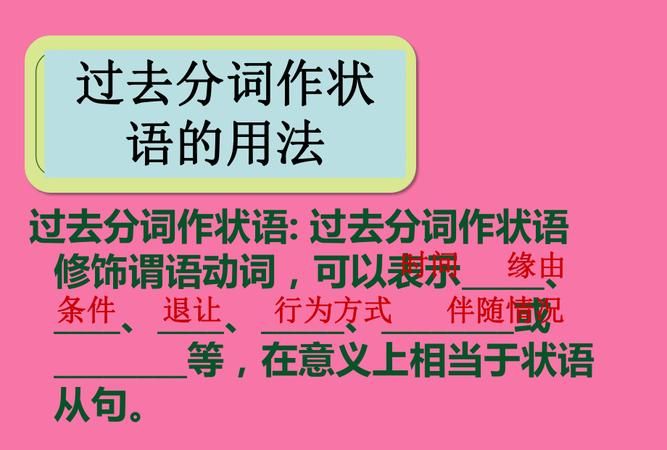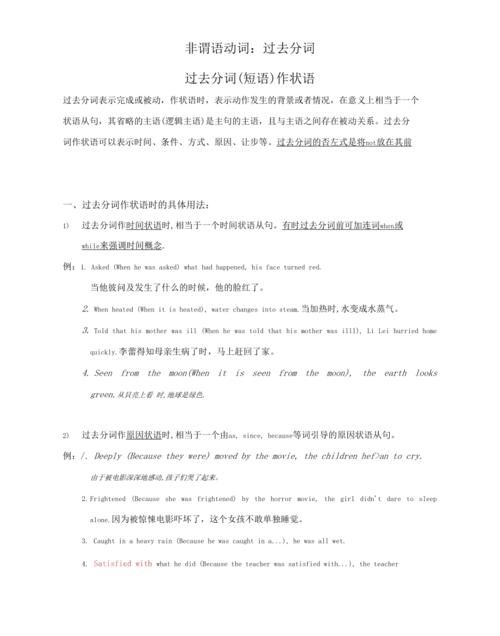本文目录
过去分词作状语的用法讲解
英语语法是针对英语语言进行研究后,系统地总结归纳出来的一系列语言规则。英语语法的精髓在于掌握语言的使用。下面是我整理的过去分词在句子中做状语的用法汇总详细解释,一起来看看吧。
过去分词在句子中做状语的用法详细解释1
一、过去分词作状语表示被动的和完成的动作。
1.Written in a hurry,this article was not so good!
因为写得匆忙,这篇文章不是很好。
2.Lost / Absorbed in deep thought,he didn't hear the sound.
因为沉溺于思考之中,所以他没听到那个声音。
二、过去分词作状语时其逻辑主语为主句的主语,此时应注意人称一致;
1.Given another hour,I can also work out this problem.
再给我一个小时,我也能解这道题.(given 为过去分词作状语,它的逻辑主语为主句主语 I,即 I 被再给一个小时。)
2.Seen from the top of the hill,the city looks more beautiful to us.
从山顶看城市,城市显得更漂亮。(seen 为过去分词作状语,表"被看",由语境可知,它的逻辑主语必须是城市,而不是"我们",因为"我们"应主动看城市。)
需要注意的是:如果过去分词作状语时,前面再加逻辑主语,主句的主语就不再是分词的逻辑主语,这种带逻辑主语的过去分词结构实际上属于独立主格结构。
3.The signal given,the bus started.
信号一发出,汽车就开动了。(the signal 是 given 的逻辑主语,因此主句主语 the bus 就不是given 的逻辑主语。
4.Her head held high,she went by.
她把头昂得高高地从这儿走了过去。(her head 是 held high 的逻辑主语,因此主句主语 she 就不再是held high 的逻辑主语。)
1.Caught in a heavy rain,he was all wet.
因为淋了一场大雨,所以他全身湿透了。 (caught in a heavy rain 为过去分词短语作原因状语,它来源于原因状语从句Because he was caught in a heavy rain.)
2.Grown in rich soil,these seeds can grow fast.
如果种在肥沃的土壤里,这些种子能长得很快。( grown in rich soil 为过去分词作条件状语,它来源于条件状语从句 If these seeds are grown in rich soil.)
四、过去分词作状语的位置.
过去分词可放在主句前作句首状语,后面有逗号与主句隔开;也可放在主句后面,前面有逗号与主句隔开。
He stood there silently,moved to tears. = Moved to tears,he stood there silently.
他静静地站在那里,被感动得热泪盈眶。
过去分词在句子中做状语的用法详细解释2
过去分词的四种用法
1.过去分词表示过去,即表示过去某时已发生的被动动作——由于既有完成的意味,又有被动意味,符合过去分词的基本特征。
2.过去分词表示同时,即表示与谓语动词同时(或几乎同时)发生的被动动作。
3.过去分词表示状态,即现在已经存在的态或过去(当时)的存在的一种被动的状态。
4.过去分词有两个基本特点,一是表示被动,二是表示完成。但有时也有例外,比如下面的.例子,虽然其中的过去分词也表示被动,但它们并不表示完成,而是表示经常性,或不表明具体的时间,带有泛指的意味。
过去分词作状语的用法归纳
过去分词或过去分词短语作状语时,表示被动和完成,在句子中一般可以作时间、原因等。
1.时间状语
Told that his mother was ill, Li Lei hurried home quickly.李蕾得知母亲生病了时,马上赶回了家。
Seen from the moon, the earth looks green.从月亮上看时,地球是绿色。
2.原因状语
Broken down on the high way, his car was carried away by the police.由于他的车在高速公路上坏了,于是被警察拖走了。
Satisfied with what he did, the teacher praised him in class.由于老师对他所做的事情很满意,于是在班上表扬了他。
3.条件状语
Given a few minutes, I’ll finish it.再给几分钟的时间,我就会完成了。
Compared with you, I still have a long way to go.跟你比较起来,我还差得很远呢。
4.让步状语
Explained a hundred times, he still can’t understand it.即使给他解释一百篇,她还是不会明白。
Trained ten hours a day, he will still be a fool.即使每天训练十个小时,他也还会是个傻瓜。
5.结果状语
He fell off a tall tree, his leg broken.他从树上摔了下来,腿摔断了。
The cup fell down to the ground, broken.茶杯掉到了地上,破碎了。
注意:一般来说,不论是动词不定式作状语、-ing分词做状语,还是动词的过去分词作状语,其逻辑主语必须是句子的主语。但是,有一些非谓语动词短语已经游离出来,成为单独的短语,在句子中作状语。如:
(1)exactly / honestly / frankly / generally speaking,准确地说不过去/老实地说/坦率地说/一般说来。如:
Exactly speaking, he got here at eight fourteen this morning.准确地说,今天早晨他是十八点十四分来到这里的。
Generally speaking, a snake won’t attack a man unless it is bothered.一般说来,蛇是不会攻击人的除非你冒犯了它。
(2)judging from/ by...从/根据某东西判断
Judging by his accent, he is from Hunan.从他的口音来判断,他是湖南人。
Judging from what he said, he is very honest.从他所说的话来判断,它是很诚实的。
(3) providing / provided…假如/如果
Providing he follows our advice, we can help him.要是他按我们的建议去做,我们就能帮助他。
Provided he is free, he is sure to come.如果他有空,他肯定会来。
(4) considering...考虑到
Considering he was just a little boy, we didn’t punish him.考虑到他还只是一个小孩,我们就没有惩罚他了。
Considering it was late, we didn’t discuss the question.考虑到时间不早了,我们就没有讨论这个问题了。
(5)thinking of...想到/考虑到
Thinking of the environment we live in, the waste can’t be thrown away around directly.考虑到我们所生存的环境,废物不能直接到处乱扔。
(6) talking of...谈到/说到
Talking of math, he became excited.谈到数学,他就兴奋起来了。
此外,还有短语:taking...into consideration把某事考虑进去;calculating roughly,粗略地计算;supposing...假定;to tell you the truth实话告诉你;to be frank坦白地说;to begin with首先要做的是;so to speak可以这么说;taken as a whole从整体上来看;put frankly,坦率地说;given that鉴于等。

过去分词作状语的用法归纳
过去分词作状语知识点归纳
过去分词作状语用法归纳
一、过去分词(短语)作状语时,其逻辑主语通常就是句子的主语。过去分词(短语)作状语一般都用逗号同其它成分隔开。
1. 作时间状语时,可转换为when或while等引导的从句,通常放在句首。如:
Seen from the top of thehill (= When it is seen from the top of the hill), the school looks like a biggarden.
2. 作条件状语时,可转换为once, if或unless等引导的从句,一般放在句首。如:
Given more attention (=If it was given more attention), the fire could have been avoided.
3. 作原因状语时,可转换为because, as或since等引导的从句,多放在句首。如:
Encouraged (= As she wasencouraged) by the teacher, the girl was very happy.
4. 作让步状语时,可转换为though, although 或even if引导的从句,常放在句首。如:
Left (= Although she wasleft) alone at home, Jenny didn’t feel afraid at all.
5. 作方式或伴随状语时,常可转换为并列分句,可位于句首或句末。如:
Surrounded by hisstudents, the teacher went into the lab. (= The teacher was surrounded by hisstudents and he went into the lab.)
6. 过去分词(短语)作状语时,有时为了强调,前面可带连词when, while,if, though, as if, unless等。如:
When given a physicalexamination, you should keep calm.
二、现在分词与过去分词作状语的区别
现在分词作状语与过去分词作状语的最主要区别就在于两者与所修饰的主语在逻辑上是主动还是被动关系。
1. 现在分词作状语时,现在分词表示的动作与主语之间在逻辑上是主动关系。如:
Not knowing what to do,he asked his good friend for help.
2. 过去分词作状语时,主语是过去分词动作的承受者,它们之间是被动关系。如:
Given more attention,the flowers could have grown better.
用括号内所给单词的适当形式填空。
1. (tell) thathis mother was ill, Li Ming hurried home quickly.
2. (satisfy)with what he did, the teacher praised him in front of his classmates.
3. (give) a fewminutes, I’ll finish the experiment.
4. (compare)with Susan, you still have a long way to go.
二、1. Told 2. Satisfied 3. Given 4. Compared

过去分词做状语
过去分词作状语的类型有:
过去分词作状语,可以表示时间、让步、条件、原因、方式等,相当于一个状语从句。其逻辑主语为主句的主语,且与主句主语构成逻辑上的动宾关系。

1、作时间状语
相当于时间状语从句。可在过去分词前加上连词when,while,until等,使其时间意义更明确。
Seen from the top of the hill,the town looks more beau-tiful.
=When the town is seen from the top of the hill,it looks more beautiful.
=When seen from the top of the hill,the town looks more beautiful.
从山顶往下看,这座城镇看起来更加漂亮。
When asked for his views about his teaching job,he said he found it very interesting and rewarding.
当问到对教学工作的观点时,他说他觉得既有趣又有意义。
2、作原因状语
相当于原因状语从句。
Satisfied with what I did,my teacher praised me in class.
=Because my teacher was satisfied with what I did,he praised me in class.
由于对我所做的事情感到满意,老师在班上表扬了我。

3、作条件状语
相当于条件状语从句。可加连词if,unless等转换成条件状语从句。
Grown in rich soil,these seeds can grow fast.
=If they are grown in rich soil,these seeds can grow fast.如果种在肥沃的土壤里,这些种子就能长得快。
过去分词做状语吗
过去分词做状语?过去分词做状语就一种啊,就是done啊,你的意思应该是非谓语动词做状语有哪几种形式是么?
to
do,表目的或者结果,动作将来发生。
doing,表主动以及动作正在进行,
done,表被动以及动作已经完成。
having
done,与主语为主动关系,且动作在另一个动作之前发生。
having
been
done,与主语为被动关系,且动作在另一个动作之前发生。

以上就是关于过去分词作状语语法形式,过去分词作状语的用法讲解的全部内容,以及过去分词作状语语法形式 的相关内容,希望能够帮到您。
